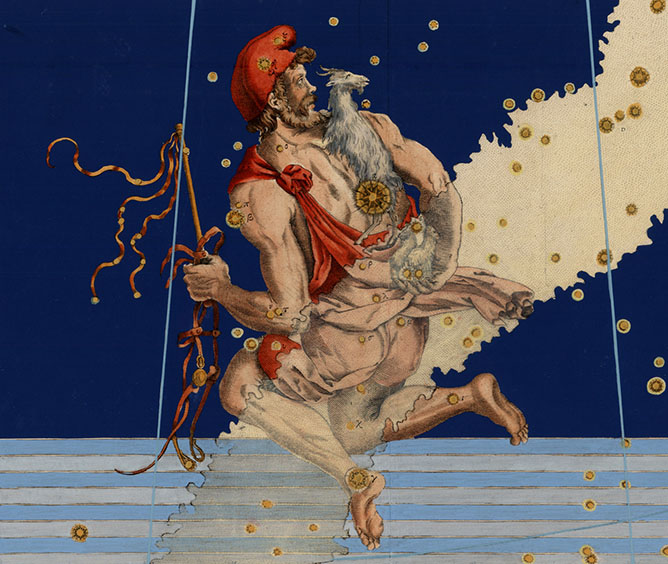Auriga: The Charioteer
Pronunciation: aw-RYE-guh Auriga as depicted by Johann Bayer in his Uranometria (1624). Source image provided by www.RareMaps.com — Barry Lawrence Ruderman Antique Maps Inc.
Auriga as depicted by Johann Bayer in his Uranometria (1624). Source image provided by www.RareMaps.com — Barry Lawrence Ruderman Antique Maps Inc.
| Auriga Constellation Profile | |
|---|---|
| Abbreviation: Aur | Genitive: Aurigae |
| Origin: Ancient | Location: Northern Hemisphere |
| Best View (North): Winter | Best View (South): |
| Bordering Constellations: Camelopardalis, Perseus, Taurus, Gemini, Lynx | |
The Myth Behind the Constellation Auriga
The Greeks saw Auriga as King Erichthonius of Athens, son of Hephaestus. He was raised by Athena and invented of the four-horse chariot known as a quadriga, which he made in the image of the Sun’s chariot. He created the chariot to cover up his legs, which were said to be serpent. To honor Erichthonius for his great invention, upon his death, Zeus put him in the night sky.Auriga Constellation Points of Interest
| Interesting Objects in the Constellation Auriga | ||||
|---|---|---|---|---|
| Name | Messier | NGC | Type | Visibility |
| M36 | NGC 1960 | Open Spiral | Binoculars | |
| M37 | NGC 2099 | Open Cluster | Binoculars | |
| M38 | NGC 1912 | Open Cluster | Binoculars | |
Bright Stars in Auriga
These are the stars in Auriga with a minimum magnitude of 3.0.| Name | Bayer Name | Magnitude | Color | Luminosity | Distance |
|---|---|---|---|---|---|
| Capella | Alpha Aurigae | 0.08 | Yellow | 162 suns | 42 ly |
| Menkalinan | Beta Aurigae | 1.90 | White | 109 suns | 82 ly |
| Mahasim | Theta Aurigae | 2.62 | White | 331 suns | 173 ly |
| Hassaleh | Iota Aurigae | 2.69 | Orange | 10,242 suns | 512 ly |